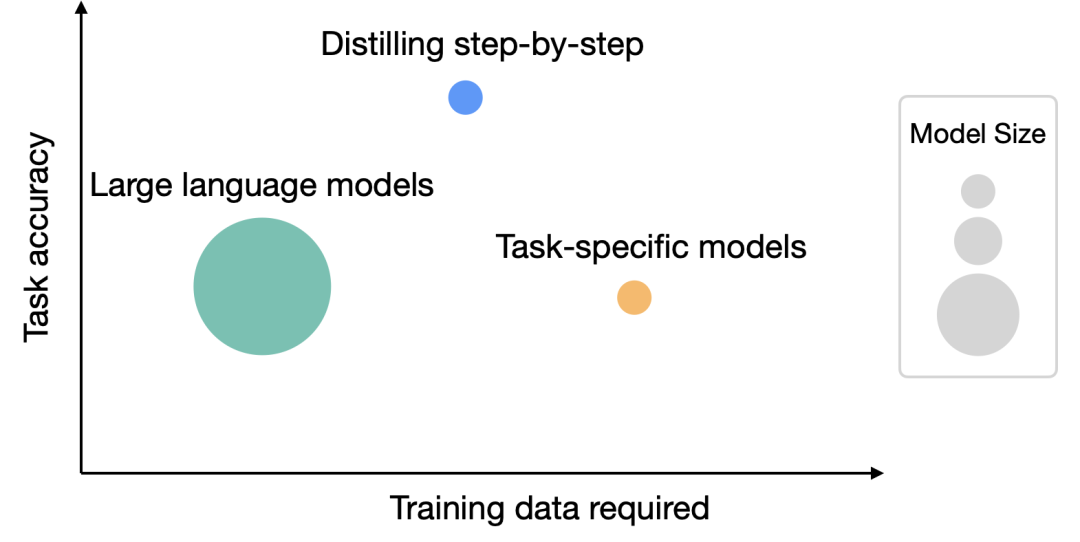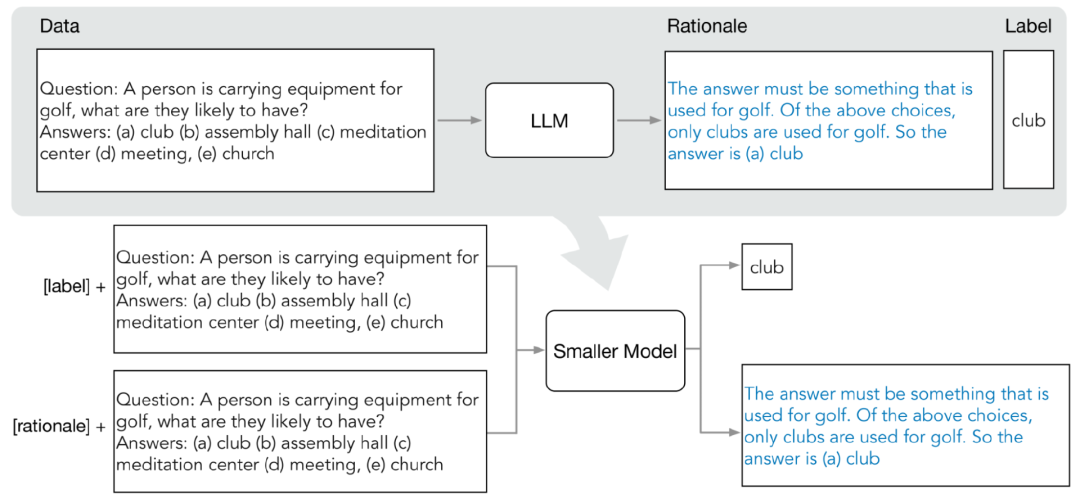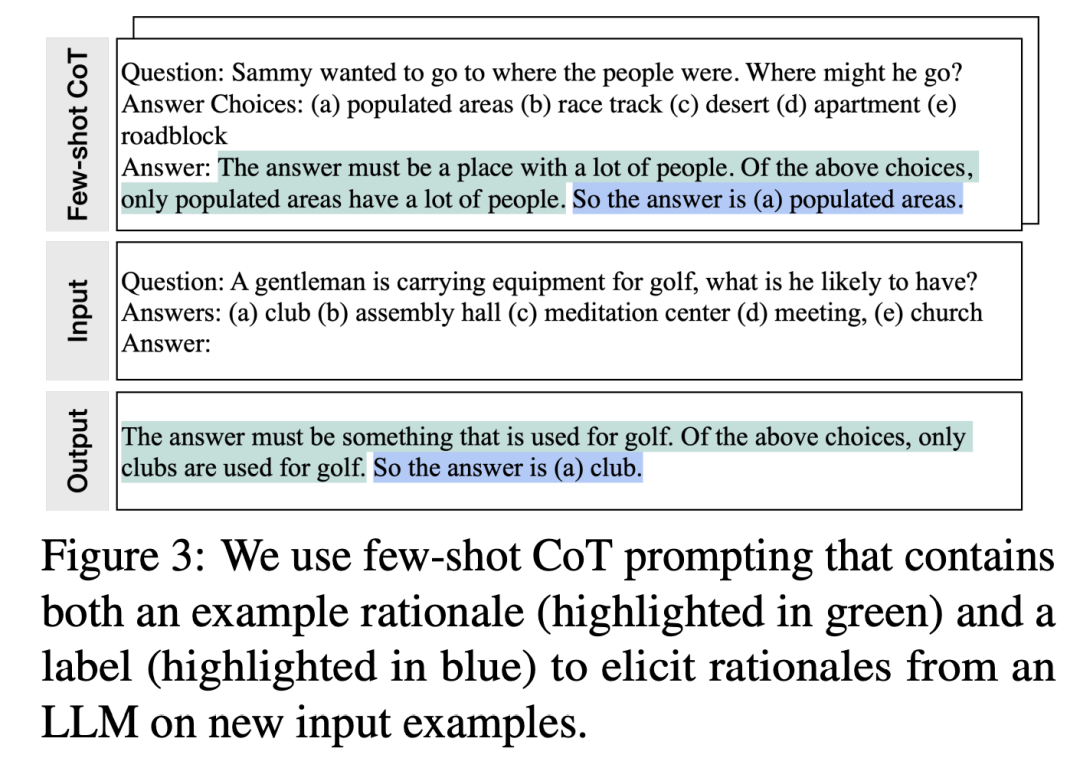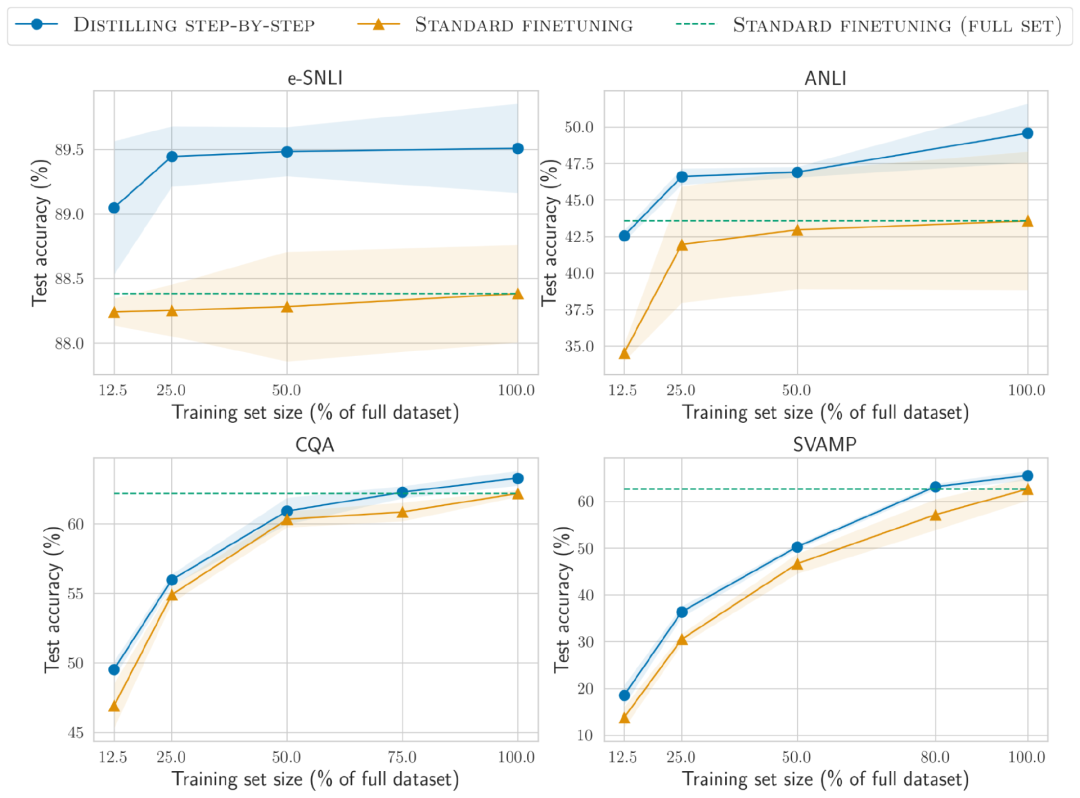 Technology peripherals
Technology peripherals
 AI
AI
 770 million parameters, exceeding 540 billion PaLM! UW Google proposes 'step-by-step distillation', which only requires 80% of training data | ACL 2023
770 million parameters, exceeding 540 billion PaLM! UW Google proposes 'step-by-step distillation', which only requires 80% of training data | ACL 2023
770 million parameters, exceeding 540 billion PaLM! UW Google proposes 'step-by-step distillation', which only requires 80% of training data | ACL 2023
Large language models excel in performance and are able to solve new tasks with zero- or few-shot hints. However, in actual application deployment, LLM is not very practical because its memory utilization efficiency is low and it requires a large amount of computing resources. For example, running a language model service with 175 billion parameters requires at least 350GB of video memory. Most of the current most advanced language models have more than 500 billion parameters. Many research teams do not have enough resources to run them, and they cannot meet the low-latency performance in real applications.
There are also some studies using manually labeled data or distillation using LLM-generated labels to train smaller, task-specific models, but fine-tuning and distillation require a large amount of training data to achieve comparable performance to LLM.
In order to solve the problem of resource requirements for large models, the University of Washington and Google collaborated to propose a new distillation mechanism called "Distilling Step-by-Step". Through step-by-step distillation, the size of the distilled model is smaller than the original model, but the performance is better, and less training data is required during the fine-tuning and distillation process

The distribution distillation mechanism extracts the prediction reason from LLM (rationale ) as additional supervisory information for training small models within a multi-task framework.
 After experiments on 4 NLP benchmarks, we found:
After experiments on 4 NLP benchmarks, we found:
1. Compared with fine-tuning and distillation, this mechanism uses less Training samples achieve better performance;
Compared with few-sample prompt LLM, this mechanism uses smaller size models to achieve better performance
3. At the same time, it reduces the model size and The data volume can also achieve better performance than LLM.
In the experiment, the 770M T5 model after fine-tuning was better than the 540B PaLM model with few sample hints in the benchmark test using only 80% of the available data, while the T5 model with the same standard fine-tuning even used 100% Data sets are also difficult to match.
Distillation method
The key idea of distribution distillation is to gradually extract information-rich prediction reasons described in natural language, that is, intermediate reasoning steps, to explain the connection between the input problem and the model output , and use these data to train small models more efficiently
 Distribution distillation mainly includes two stages:
Distribution distillation mainly includes two stages:
1. From Extraction principle (rationale) in LLMResearchers use the few-sample Chain of Thinking (CoT) prompt to extract the prediction intermediate steps from LLM.
After determining the target task, first prepare several samples in the LLM input prompt. Each example consists of a triplet, including input, principle and output
 After inputting prompts, LLM can imitate the triplet demonstration to generate other new problems. Prediction principle, for example, in the common sense question and answer task, given
After inputting prompts, LLM can imitate the triplet demonstration to generate other new problems. Prediction principle, for example, in the common sense question and answer task, given
Sammy wants to go to a place where crowds gather. Where will he choose? The options are: (a) densely populated area, (b) race track, (c) desert, (d) apartment, (e) roadblock
(Sammy wanted to go to where the people are. Where might he go? Answer Choices: (a) populated areas, (b) race track, (c) desert, (d) apartment, (e) roadblock)After gradual refinement, LLM You can give the correct answer to the question "(a) Densely populated area" and provide a reason for answering the question "The answer must be a place with many people. Among the above choices, only densely populated areas have many people." After gradual refinement, LLM was able to conclude that the correct answer is "(a) densely populated area" and provided the reason for answering the question "The answer must be a place with many people. Among the above choices, only densely populated areas have many people." people."
By providing CoT examples paired with rationales in prompts, the contextual learning capability allows LLM to generate appropriate answer reasons for unencountered question types
2. Training Mini Model
By constructing the training process as a multi-task problem, the reasons for prediction can be extracted and incorporated into the training small model
In addition to the standard label prediction task In addition, the researchers also used a new reason generation task to train a small model, so that the model can learn to generate intermediate reasoning steps for prediction, and guide the model to better predict the result label.
Distinguish label prediction and reason generation tasks by adding the task prefixes "label" and "rationale" to the input prompt.
Experimental results
In the experiment, the researchers selected the PaLM model with 540 billion parameters as the LLM baseline, and used the T5 model as the task-related downstream small model.
In this study, we conducted experiments on four benchmark datasets, namely e-SNLI and ANLI for natural language reasoning, CQA for common sense question answering, and SVAMP for Application problems in arithmetic and mathematics. We conducted experiments on these three different NLP tasks
Less training data
The stepwise distillation method performs better than Standard fine-tuning is better and requires less training data
On the e-SNLI dataset, better performance than standard fine-tuning is achieved when using 12.5% of the full dataset, on ANLI, Only 75%, 25% and 20% of the training data are required on CQA and SVAMP respectively.

Compared to standard fine-tuning using a 220M T5 model on manually labeled datasets of varying sizes, distribution distillation is superior when using fewer training examples across all datasets. Distribution compared to LLM prompted by few-shot CoT Distillation results in a model that is much smaller in size but performs better.
On the e-SNLI data set, using the 220M T5 model achieves better performance than the 540B PaLM; on ANLI, using the 770M T5 model achieves better performance than the 540B PaLM. Model size is only 1/700Smaller model, less data
While reducing model size and training data , we successfully achieved performance exceeding few-shot PaLM
In ANLI, outperforming 540B PaLM using a 770M T5 model, while using only 80% of the full dataset
It has been observed that standard fine-tuning cannot reach the performance level of PaLM even with the complete 100% data set, indicating that stepwise distillation can simultaneously reduce the model size and the amount of training data, thereby achieving Performance beyond LLMThe above is the detailed content of 770 million parameters, exceeding 540 billion PaLM! UW Google proposes 'step-by-step distillation', which only requires 80% of training data | ACL 2023. For more information, please follow other related articles on the PHP Chinese website!

Hot AI Tools

Undresser.AI Undress
AI-powered app for creating realistic nude photos

AI Clothes Remover
Online AI tool for removing clothes from photos.

Undress AI Tool
Undress images for free

Clothoff.io
AI clothes remover

AI Hentai Generator
Generate AI Hentai for free.

Hot Article

Hot Tools

Notepad++7.3.1
Easy-to-use and free code editor

SublimeText3 Chinese version
Chinese version, very easy to use

Zend Studio 13.0.1
Powerful PHP integrated development environment

Dreamweaver CS6
Visual web development tools

SublimeText3 Mac version
God-level code editing software (SublimeText3)

Hot Topics
 1378
1378
 52
52
 How to implement file sorting by debian readdir
Apr 13, 2025 am 09:06 AM
How to implement file sorting by debian readdir
Apr 13, 2025 am 09:06 AM
In Debian systems, the readdir function is used to read directory contents, but the order in which it returns is not predefined. To sort files in a directory, you need to read all files first, and then sort them using the qsort function. The following code demonstrates how to sort directory files using readdir and qsort in Debian system: #include#include#include#include#include//Custom comparison function, used for qsortintcompare(constvoid*a,constvoid*b){returnstrcmp(*(
 How to optimize the performance of debian readdir
Apr 13, 2025 am 08:48 AM
How to optimize the performance of debian readdir
Apr 13, 2025 am 08:48 AM
In Debian systems, readdir system calls are used to read directory contents. If its performance is not good, try the following optimization strategy: Simplify the number of directory files: Split large directories into multiple small directories as much as possible, reducing the number of items processed per readdir call. Enable directory content caching: build a cache mechanism, update the cache regularly or when directory content changes, and reduce frequent calls to readdir. Memory caches (such as Memcached or Redis) or local caches (such as files or databases) can be considered. Adopt efficient data structure: If you implement directory traversal by yourself, select more efficient data structures (such as hash tables instead of linear search) to store and access directory information
 How debian readdir integrates with other tools
Apr 13, 2025 am 09:42 AM
How debian readdir integrates with other tools
Apr 13, 2025 am 09:42 AM
The readdir function in the Debian system is a system call used to read directory contents and is often used in C programming. This article will explain how to integrate readdir with other tools to enhance its functionality. Method 1: Combining C language program and pipeline First, write a C program to call the readdir function and output the result: #include#include#include#includeintmain(intargc,char*argv[]){DIR*dir;structdirent*entry;if(argc!=2){
 Debian mail server firewall configuration tips
Apr 13, 2025 am 11:42 AM
Debian mail server firewall configuration tips
Apr 13, 2025 am 11:42 AM
Configuring a Debian mail server's firewall is an important step in ensuring server security. The following are several commonly used firewall configuration methods, including the use of iptables and firewalld. Use iptables to configure firewall to install iptables (if not already installed): sudoapt-getupdatesudoapt-getinstalliptablesView current iptables rules: sudoiptables-L configuration
 How to learn Debian syslog
Apr 13, 2025 am 11:51 AM
How to learn Debian syslog
Apr 13, 2025 am 11:51 AM
This guide will guide you to learn how to use Syslog in Debian systems. Syslog is a key service in Linux systems for logging system and application log messages. It helps administrators monitor and analyze system activity to quickly identify and resolve problems. 1. Basic knowledge of Syslog The core functions of Syslog include: centrally collecting and managing log messages; supporting multiple log output formats and target locations (such as files or networks); providing real-time log viewing and filtering functions. 2. Install and configure Syslog (using Rsyslog) The Debian system uses Rsyslog by default. You can install it with the following command: sudoaptupdatesud
 How to configure firewall rules for Debian syslog
Apr 13, 2025 am 06:51 AM
How to configure firewall rules for Debian syslog
Apr 13, 2025 am 06:51 AM
This article describes how to configure firewall rules using iptables or ufw in Debian systems and use Syslog to record firewall activities. Method 1: Use iptablesiptables is a powerful command line firewall tool in Debian system. View existing rules: Use the following command to view the current iptables rules: sudoiptables-L-n-v allows specific IP access: For example, allow IP address 192.168.1.100 to access port 80: sudoiptables-AINPUT-ptcp--dport80-s192.16
 How to set the Debian Apache log level
Apr 13, 2025 am 08:33 AM
How to set the Debian Apache log level
Apr 13, 2025 am 08:33 AM
This article describes how to adjust the logging level of the ApacheWeb server in the Debian system. By modifying the configuration file, you can control the verbose level of log information recorded by Apache. Method 1: Modify the main configuration file to locate the configuration file: The configuration file of Apache2.x is usually located in the /etc/apache2/ directory. The file name may be apache2.conf or httpd.conf, depending on your installation method. Edit configuration file: Open configuration file with root permissions using a text editor (such as nano): sudonano/etc/apache2/apache2.conf
 How Debian OpenSSL prevents man-in-the-middle attacks
Apr 13, 2025 am 10:30 AM
How Debian OpenSSL prevents man-in-the-middle attacks
Apr 13, 2025 am 10:30 AM
In Debian systems, OpenSSL is an important library for encryption, decryption and certificate management. To prevent a man-in-the-middle attack (MITM), the following measures can be taken: Use HTTPS: Ensure that all network requests use the HTTPS protocol instead of HTTP. HTTPS uses TLS (Transport Layer Security Protocol) to encrypt communication data to ensure that the data is not stolen or tampered during transmission. Verify server certificate: Manually verify the server certificate on the client to ensure it is trustworthy. The server can be manually verified through the delegate method of URLSession



